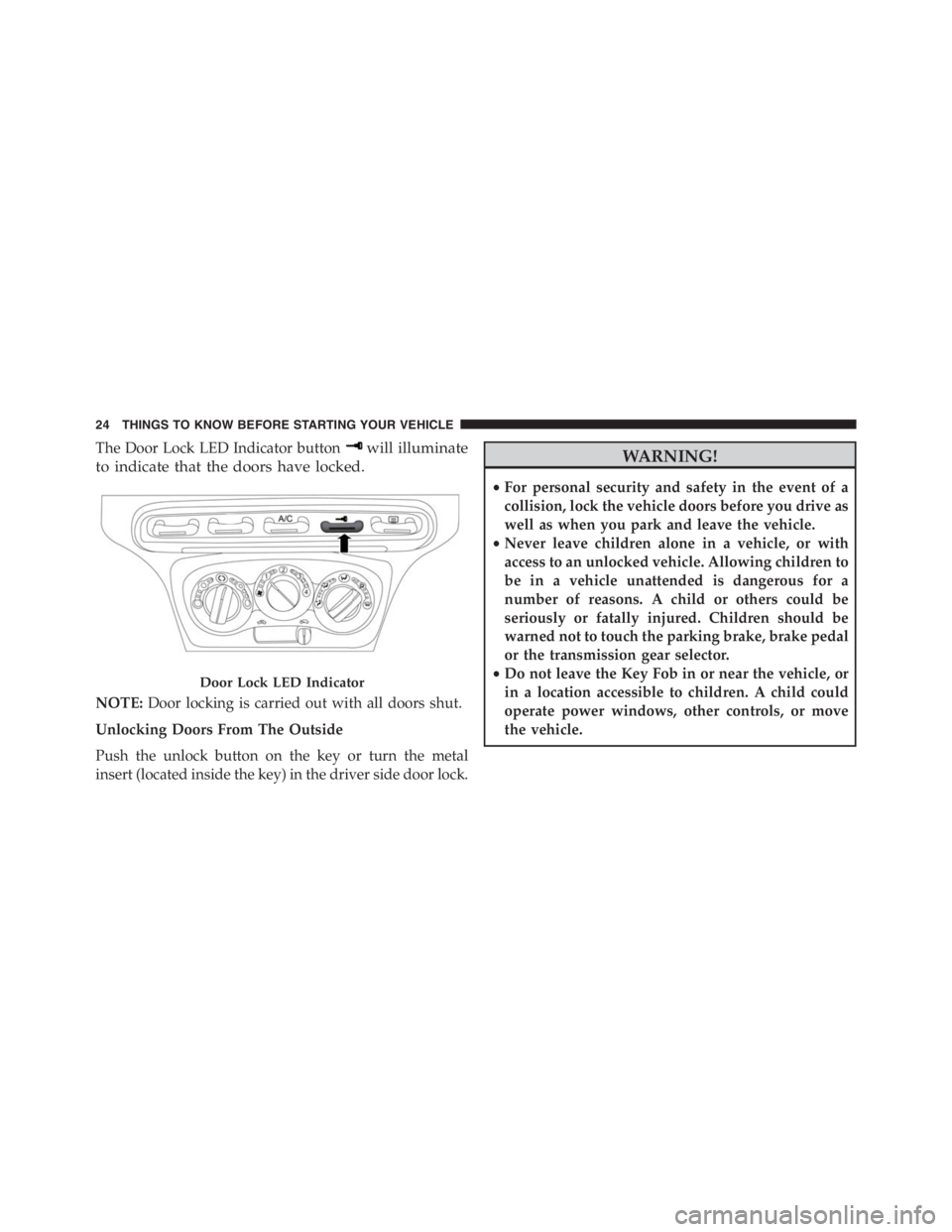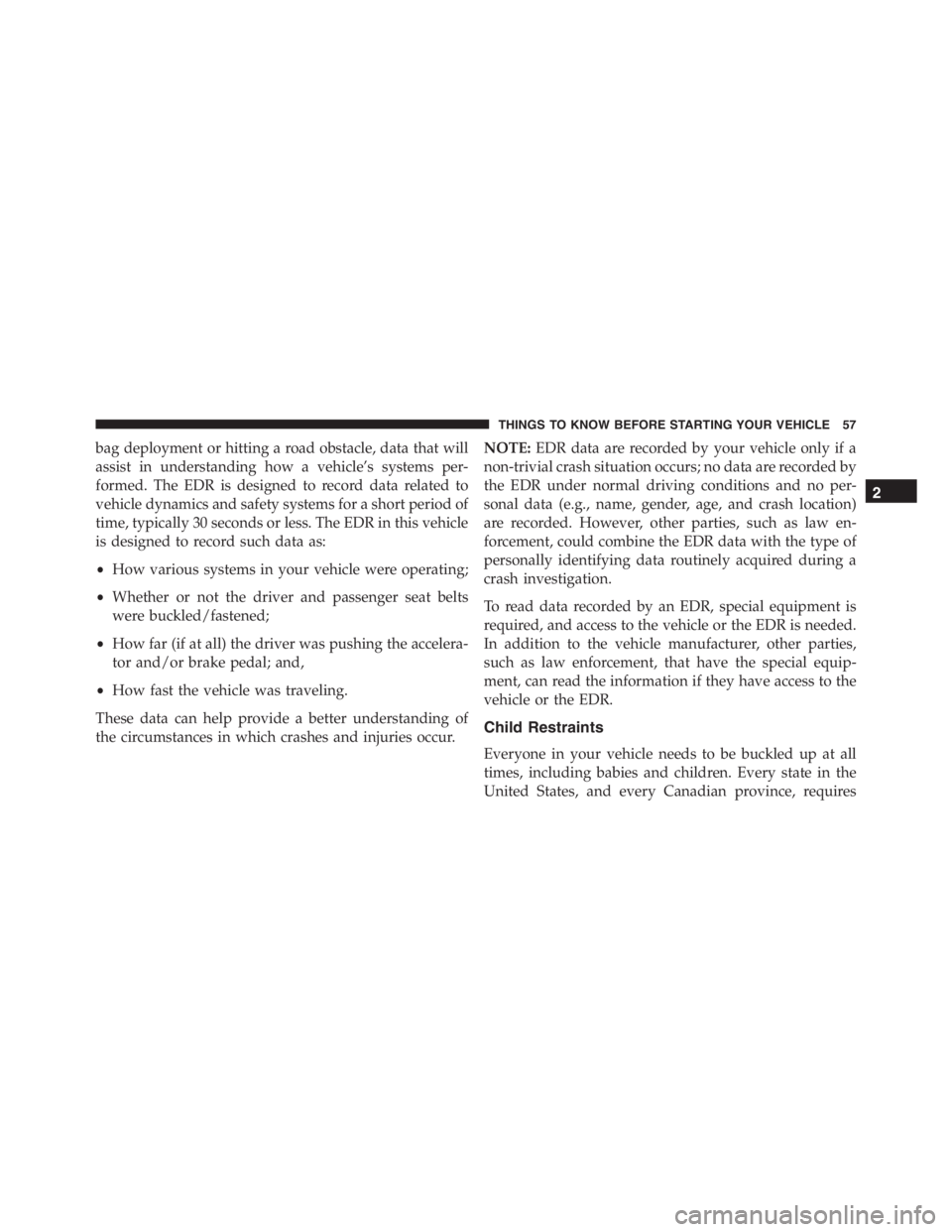Page 13 of 348
A WORD ABOUT YOUR KEYS
The key fob contains the Remote Keyless Entry (RKE)
transmitter with an integrated key. To use the mechanical
key simply push the mechanical key release button.
Ignition Key Removal
1. Push the brake pedal and place the transmission into
first (1) or reverse (R) gear by selecting/pushing the
buttons on the console.
2. Rotate the key to the STOP (OFF/LOCK) position and
engage the handbrake and release brake pedal.
Key Fob1 — Vehicle Key
2 — Push To Open/Close Vehicle KeyTransmission Gear Selector
2
THINGS TO KNOW BEFORE STARTING YOUR VEHICLE 11
Page 14 of 348
3. Remove the key from the ignition switch lock cylinder.WARNING!
•Before exiting the vehicle, always apply the park-
ing brake, and remove the Key Fob from the
ignition. When leaving the vehicle, always lock
your vehicle.
•Never leave children alone in a vehicle, or with
access to an unlocked vehicle.
•Allowing children to be in a vehicle unattended is
dangerous for a number of reasons. A child or
others could be seriously or fatally injured. Chil-
dren should be warned not to touch the parking
brake, brake pedal or the transmission gear selec-
tor.
•Do not leave the Key Fob in or near the vehicle, or
in a location accessible to children. A child could
operate power windows, other controls, or move
the vehicle.
(Continued)
Ignition Switch Positions
1 — STOP (OFF/LOCK)
2 — MAR (ACC/ON/RUN)
3 — AVV (START) 12 THINGS TO KNOW BEFORE STARTING YOUR VEHICLE
Page 26 of 348

The Door Lock LED Indicator buttonwill illuminate
to indicate that the doors have locked.
NOTE:Door locking is carried out with all doors shut.
Unlocking Doors From The Outside
Push the unlock button on the key or turn the metal
insert (located inside the key) in the driver side door lock.
WARNING!
•For personal security and safety in the event of a
collision, lock the vehicle doors before you drive as
well as when you park and leave the vehicle.
•Never leave children alone in a vehicle, or with
access to an unlocked vehicle. Allowing children to
be in a vehicle unattended is dangerous for a
number of reasons. A child or others could be
seriously or fatally injured. Children should be
warned not to touch the parking brake, brake pedal
or the transmission gear selector.
•Do not leave the Key Fob in or near the vehicle, or
in a location accessible to children. A child could
operate power windows, other controls, or move
the vehicle.
Door Lock LED Indicator
24 THINGS TO KNOW BEFORE STARTING YOUR VEHICLE
Page 33 of 348

sure that the decklid is completely closed and not only
fastened in safety position by trying to open it. If it is
not completely closed, do not push the decklid down,
but raise it and repeat the procedure.
NOTE:Always check that the decklid is closed correctly
to prevent it from opening while the car is travelling.
WARNING!
•The maximum permitted load in the luggage com-
partment, in addition to the kits provided, is
33.1 lbs. (15 kg). Do not exceed the maximum
permitted load in the luggage compartment.
•When accessing the rear luggage compartment, do
not come into contact with engine, or other compo-
nents, that may be hot and could burn you if
touched.
(Continued)
WARNING!(Continued)
•Access the luggage compartment only with the
vehicle stationary. Before exiting a vehicle, you
should always shift the vehicle into gear, remove
the key fob from the ignition, and apply the
parking brake to secure the vehicle against un-
wanted movement.
•The decklid may drop suddenly, causing serious
injury, if the supporting rod is not positioned
correctly.
•The decklid must always be closed properly, and
the lock engaged, while the car is in motion.2
THINGS TO KNOW BEFORE STARTING YOUR VEHICLE 31
Page 59 of 348

bag deployment or hitting a road obstacle, data that will
assist in understanding how a vehicle’s systems per-
formed. The EDR is designed to record data related to
vehicle dynamics and safety systems for a short period of
time, typically 30 seconds or less. The EDR in this vehicle
is designed to record such data as:
•How various systems in your vehicle were operating;
•Whether or not the driver and passenger seat belts
were buckled/fastened;
•How far (if at all) the driver was pushing the accelera-
tor and/or brake pedal; and,
•How fast the vehicle was traveling.
These data can help provide a better understanding of
the circumstances in which crashes and injuries occur.NOTE:EDR data are recorded by your vehicle only if a
non-trivial crash situation occurs; no data are recorded by
the EDR under normal driving conditions and no per-
sonal data (e.g., name, gender, age, and crash location)
are recorded. However, other parties, such as law en-
forcement, could combine the EDR data with the type of
personally identifying data routinely acquired during a
crash investigation.
To read data recorded by an EDR, special equipment is
required, and access to the vehicle or the EDR is needed.
In addition to the vehicle manufacturer, other parties,
such as law enforcement, that have the special equip-
ment, can read the information if they have access to the
vehicle or the EDR.
Child Restraints
Everyone in your vehicle needs to be buckled up at all
times, including babies and children. Every state in the
United States, and every Canadian province, requires
2
THINGS TO KNOW BEFORE STARTING YOUR VEHICLE 57
Page 74 of 348

Floor Mat Safety Information
Always use floor mats designed to fit the foot well of
your vehicle. Use only floor mats that leave the pedal
area unobstructed and that are firmly secured so that
they cannot slip out of position and interfere with the
pedals or impair safe operation of your vehicle in other
ways.
Periodic Safety Checks You Should Make Outside
The Vehicle
Tires
Examine tires for excessive tread wear and uneven wear
patterns. Check for stones, nails, glass, or other objects
lodged in the tread. Inspect the tread and sidewall for
cuts and cracks. Check the wheel nuts for tightness.
Check the tires for proper pressure.
Lights
Have someone observe the operation of brake lights and
exterior lights while you work the controls. Check turn
signal and high beam indicator lights on the instrument
panel.
Door Latches
Check for positive closing, latching, and locking.
Fluid Leaks
Check area under vehicle after overnight parking for fuel,
engine coolant, oil, or other fluid leaks. Also, if gasoline
fumes are detected or if fuel, power steering fluid (if
equipped), or brake fluid leaks are suspected, the cause
should be located and corrected immediately.
72 THINGS TO KNOW BEFORE STARTING YOUR VEHICLE
Page 87 of 348
WARNING!(Continued)
•Access the luggage compartment only with the
vehicle stationary. Before exiting the vehicle, you
should always place the vehicle into First gear,
apply the parking brake, and remove the key from
the ignition. Never leave the key fob in the vehicle
or in a location accessible to children.
•The decklid may drop suddenly, causing serious
injury, if the supporting rod is not positioned
correctly.
•The decklid must always be closed properly, and
the lock engaged, while the vehicle is in motions.
LIGHTS
Multifunction Lever
The multifunction lever, located on the left side of the
steering wheel, controls the operation of the headlights,
headlight beam selection, passing light and turn signals.NOTE:The external lights can only be turned on with
the ignition in the ON/RUN position.
Multifunction Lever
3
UNDERSTANDING THE FEATURES OF YOUR VEHICLE 85
Page 96 of 348

To Activate
Rotate the end of the multifunction lever to activate the
Electronic Speed Control. The Cruise Indicator Light in
the Electronic Vehicle Information Center (EVIC) will
illuminate. To turn the system off, rotate the end of the
multifunction lever to the “O” position. The Cruise
Indicator Light will turn off. The system should be
turned off when not in use.
WARNING!
Leaving the Electronic Speed Control system on
when not in use is dangerous. You could accidentally
set the system or cause it to go faster than you want.
You could lose control and have an accident. Always
leave the system OFF when you are not using it.
To Set A Desired Speed
Turn the Electronic Speed Control ON. When the vehicle
has reached the desired speed, move the electronic speed
control lever upward SET(+) and release. Release the
accelerator and the vehicle will operate at the selected
speed.
NOTE:The vehicle should be traveling at a steady speed
and on level ground before moving the electronic speed
control lever upward SET(+).
To Deactivate
A soft tap on the brake pedal, pushing the RESUME/
CANCEL button, or normal brake pressure while slow-
ing the vehicle will deactivate Electronic Speed Control
without erasing the set speed memory. Rotating the end
of the multifunction lever to the “O” position or turning
the ignition switch OFF erases the set speed memory.
94 UNDERSTANDING THE FEATURES OF YOUR VEHICLE